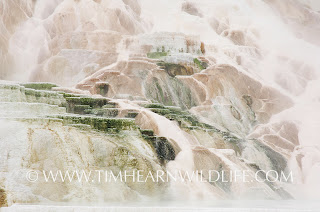WELCOME!
Welcome to the temporary site for timhearnwildlife.com.
I'll be posting a few shots here while working on the main site, which is currently under construction...
Timhearnwildlife has been a long term passion and project of mine which is now reaching fruition. It is (or strictly speaking, will be) a commercial resource for wildlife and natural history photography and writing.
Over the last 10 years, I've been fortunate enough to travel extensively to all 7 continents, taking photographs and notes, and the site will showcase the results.
Please feel free to browse....
Blog Archive
- March 2013 (1)
- September 2011 (2)
- June 2011 (1)
- May 2011 (1)
- April 2011 (3)
- March 2011 (1)
- February 2011 (1)
- January 2011 (7)
- December 2010 (3)
- November 2010 (11)
- October 2010 (11)
- September 2010 (14)
- August 2010 (7)
- July 2010 (12)
Tuesday, 9 November 2010
MAMMOTH SPRINGS
Yellowstone Park, USA. Some of the most gorgeous scenery I've ever seen. And some of the weirdest, as befits a national park sitting smack on top of a supervolcano. A supervolcano, for the benefit of the Brits, is one that's very big and not, as the name implies, one that's really rather smashing.
Volcanoes are measured by the amount of stuff they blast out (ejecta). And like the Richter scale, this is measured on a single-figure scale, known as the VEI (volcanic explosivity index).
Yellowstone's last eruption, 640,000 years ago, had a VEI of 8, which means it spewed about 1000 cubic kilometers of ejecta. By comparison, Krakatoa in 1883 was VEI 6, or about 25 cubic kilometers. A supervolcano eruption is a world changing event, which could trigger a mini ice age and possible species extinction. The species in question being, well, us. Or at the very least the good folks of the United States.
Since that would leave us without cheeseburgers and Bruce Springsteen, this puts a Yellowstone eruption firmly inside my definition of a cataclysmic event. And the worrying thing is that in volcanic terms, it's overdue. It could happen at literally any moment within the next 150,000 years or so. Scary stuff, eh?
So, Mammoth Springs is one of the many places in Yellowstone where the earth leaks hot minerals and suchlike. These cool and crystalise, forming extraordinary shapes and patterns. The colours are due to the minerals and the algae and bacteria that live happily in the rich deposits.
I was there in midwinter, and the steam and sulphur dioxide rising off the cooling mineral salts produced an eerie steam and a heinous smell. At least, I think it was the mineral salts.
Yellowstone is great, but Mammoth Springs is like visiting another planet. It has to be seen to be believed.
Oh, and eat cheeseburgers while you can. Lots of them. Because you never know what the next 150,000 years might bring.
Labels:
eruption,
Mammoth Springs,
Supervolcano,
Volcano,
Yellowstone
Subscribe to:
Post Comments (Atom)



No comments:
Post a Comment